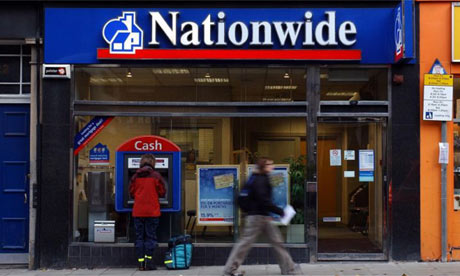Building society
The building societies are special credit institutions operating, only the housing finance due to the business district restriction, for example, regulated in the German Building Societies Act substantially.
The basic idea
The basic idea of building savings can illustrate this with the following example:
Ten property developers without capital save with the aim to acquire a residential property. If everyone is able to save one-tenth of the labor costs per year, so everyone would have accumulated the necessary capital after ten years. Bring the ten Bauwilligen their savings into a common " money box " one, then from this the sum needed the first of them already paid after one year ( allocation ) are (one-tenth as repayment of the services saving power and nine-tenths as housing loans ). If it is now assumed that the assigned home savings each year one-tenth of the resulting contract sum to repay the loan as repayment of the building loan in the common " allocation pot ", then the second home savings customers realize his construction project in the second year. In the third year, under the same conditions, eight savings and repayments in two " allocation pot ", so that the third building savings contract can be allocated.
The building society reality is somewhat more complicated, since there are no closed building society group. Nevertheless, the present building society system is based on the illustrated basic idea of the collective building savings.
History
The building society system underlying collective saving idea has been realized around 200 BC in China. During the Han Dynasty profit savings companies were founded on reciprocity.
The first building society was created in 1775 in Birmingham, then in the USA ( 1831), in Australia and New Zealand ( 1832), in South Africa ( 1833) and Brazil (1834 ).
1885 by Pastor of Bodelschwinghstraße in Bielefeld, the first German building society, founded in the building society for everyone.
Definitively could the building society system in the years 1924 to 1929, establish due to the high cash demand for reconstruction after the First World War in Germany. Until then there was in Germany for a number of smaller property developers settlers, some regionally limited and usually established with limited liability " construction and savings associations gGmbH " that worked on similar principles (see also housing cooperatives ).
In the late 1930s there was the first fundamental change in the German building society system. The hitherto customary " lottery system " was replaced by an evaluation process, which was fairer. It made the award date of the individual Bausparers of the way his savings capital formation dependent.
After the currency reform of 1948 began with the economic miracle of the upturn in the German building societies.
In 1973, the Building Societies Act and the building society regulation in force. Thus, a uniform legal basis is established for the activity of private and public building societies.
Due to the amendment of the Building Society Act 1991, building societies the way to the European Single Market was opened. At the same time the possibility of micro-loans and unsecured loans for an extensive package was created building society technical safeguards.
Legal forms
Building societies differ from one another in their legal forms.
The merged in the Union of 12 private building societies Building societies are organized in the legal form of joint-stock companies and are mostly owned or sphere of influence of insurance companies or banks. Due to the building society building society law must be a single entity, which is why banks society business can not perform directly, but only through subsidiaries.
Unlike in the banking sector, there is no separation between private and cooperative institutions. A special form is thus the building society Schwäbisch Hall, the DZ Bank (owned by people and Raiffeisen banks) is majority owned. About a special role in the camp of private building societies also came BHW, which was a private company though, was until 2005, however, supported by the German Civil Service Federation and the German Federation of Trade Unions. January 2, 2006 BHW was acquired by Postbank.
The second building society group, currently 10 building societies, consists of institutions that are mainly under the auspices of one or more states and / or the respective savings bank organization. The building societies are members of the German Savings Banks and Giro Association and are supervised from there through the federal office building societies.
Four regional building societies are dependent departments / divisions of a state bank or savings bank. They are still, according to the Building Societies Act, building societies as independent.
Three building societies are legally responsible institutions under public law.
Due to the regional zoning on individual or group of states, not available to building societies, in contrast to the nation-wide, private building societies compete with each other.
Building society promotion in Germany
In the Federal Republic of Germany, the building society by granting housing premiums for savings services to building society accounts and the payment of employees' savings allowances for capital accumulation benefits is encouraged. On July 4, 2008, residential Riester was in the Federal Home Ownership Pension Act, known as introduced. This looks from 1 November 2008, additional funding public housing.
Building societies in Germany
The savings market in Germany is covered to about two-thirds by 15 private building societies and about one-third by ten Landesbausparkassen.
Building society promotion in Austria
In Austria, building society promoted by the state building society bonus. The premium amount is determined annually and is based on the general level of interest rates. It is at least 1.5 percent and a maximum of 4.0 percent. Funding per person per year payments of up to € 1,000.00 (2008) - from 2009 up to 1.200,00 EUR. The tax commitment period is six years. Upon termination of the savings agreement before this period, the premium must be paid back. If the amount saved is demonstrably used for certain residential real measures such as building or renovation, the building society bonus is maintained.
The development of the savings premiums in the past eleven years:
- 2003 to 4.0 percent
- 2004 to 3.5 percent
- 2005 to 3.5 percent
- 2006 to 3.0 percent
- 2007 to 3.5 percent
- 2008 to 4.0 percent
- 2009 to 4.0 percent
- 2010 to 3.5 percent
- 2011 to 3.0 percent
- 2012 to 1.875 percent
- 2013 to 1.5 percent
Building societies in Austria
In Austria, there are four building societies:
- General Building Society ( ABV)
- Raiffeisen building society
- Wüstenrot AG
- S building society










